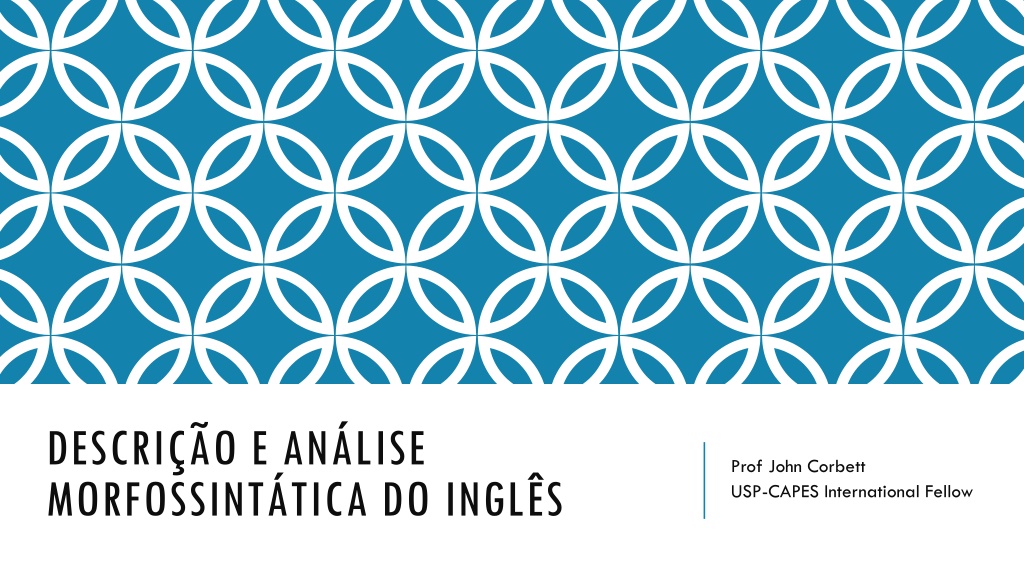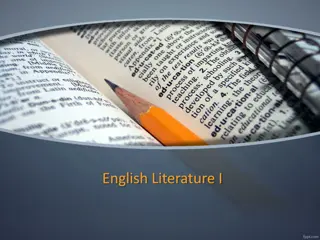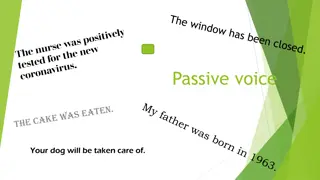Understanding English Phrase Structure: Analysis and Examples
Explore the morphosyntactic analysis of English phrases and the grammatical hierarchy, delving into sentence constituents, clauses, phrases, words, and morphemes. Learn about different types of phrases, their structures, and elements like modifiers, headwords, and grammatical markers, with illustrative examples provided. Gain insights into noun phrases, verb phrases, and adjective phrases, as well as the importance of sentence structures in English.
Download Presentation

Please find below an Image/Link to download the presentation.
The content on the website is provided AS IS for your information and personal use only. It may not be sold, licensed, or shared on other websites without obtaining consent from the author. Download presentation by click this link. If you encounter any issues during the download, it is possible that the publisher has removed the file from their server.
E N D
Presentation Transcript
DESCRIO E ANLISE MORFOSSINT TICA DO INGL S Prof John Corbett USP-CAPES International Fellow
PHRASE STRUCTURE IN THE GRAMMATICAL HIERARCHY Sentence Constituents: Sentence: Clause: Phrase: Word: Morpheme: Main clause(s) plus possible subordinate clauses. (SPOCA) Subject/Predicator/Object/Complement/Adverbial Noun Phrase/Verb Phrase/Prepositional Phrase, etc. Noun/Verb/Adjective/Preposition, etc. prefixes, roots and suffixes
TODAYS SESSION Types of phrase Phrase structure: x M H
TODAYS SESSION Types of phrase Phrase structure: x M H x = grammatical marker M = Modifier H = Headwords Phrases are made up of a headword, one or more optional modifiers and possibly a grammatical marker. These are functional labels.
PHRASE STRUCTURE Types of Phrase: M M (the little red hen) NP d Aj M H Noun Phrase Aj N
PHRASE STRUCTURE Types of Phrase: M M (the little red hen) NP d Aj M H Noun Phrase Aj N A test for adjectiveness the little hen the hen is little the red hen the hen is red the hen *hen is the
PHRASE STRUCTURE Types of Phrase M H (very little) AjP Av Aj Adjective Phrase
PHRASE STRUCTURE Types of Phrase M H (very little) AjP Av Aj Adjective Phrase Notice there is no noun. The modifying adverb has an intensifying function.
PHRASE STRUCTURE Types of Phrase: M H (is running) VP a V Verb Phrase
PHRASE STRUCTURE Types of Phrase: M H (is running) VP a V Verb Phrase Note that the structure of the VP is to have an open class verb as headword and one or more closed class auxiliaryVerbs as modifiers, eg M M (might have been running) VP a a M H a V
PHRASE STRUCTURE Types of Phrase: M H (very quickly) AvP Av Av Adverb Phrase
PHRASE STRUCTURE Types of Phrase: M H (very quickly) AvP Av Av Adverb Phrase Notice we have two different types of adverb here one that intensifies, and an adverb of manner. Intensifying adverbs are modifiers, not headwords.
PHRASE STRUCTURE x M H (in the yard) PP pr d N Prepositional Phrase Note that the preposition functions neither as a modifier nor as a headword. It has a grammatical function, ie it links the following NP to the rest of the sentence.
PHRASE STRUCTURE Types of Phrase: H Genitive Phrase (Bill s) N GP
PHRASE STRUCTURE Types of Phrase: H Genitive Phrase (Bill s) N GP Genitive means possessive . The headword is a noun. These special NPs are marked by apostrophe + s . The form survives from Old English but has been joined by an alternative, of Bill which was originally a French structure.
PHRASE STRUCTURE Types of Phrase: M M (the little red hen) NP d Aj M H (is running) VP a V M H (very quickly) AvP Av Av M H (very quick) AjP Av Aj x M H (in the yard) PP pr d N H (Bill s) GP N M H Noun Phrase Aj N Verb Phrase Adverb Phrase Adjective Phrase Prepositional Phrase Genitive Phrase
APPLYING PHRASE STRUCTURE: OFF COURSE BY EDWIN MORGAN the golden flood the weightless seat the cabin song the pitch black the growing beard the floating crumb the shining rendezvous the orbit wisecrack the hot spacesuit the smuggled mouth-organ the imaginary somersault the visionary sunrise the turning continents the space debris the golden lifeline the space walk the crawling deltas the camera moon the pitch velvet the rough sleep the crackling headphone the space silence the turning earth the lifeline continents
OFF COURSE BY EDWIN MORGAN (CONTINUED) the cabin sunrise the hot flood the shining spacesuit the growing moon the crackling somersault the smuggled orbit the rough moon the visionary rendezvous the weightless headphone the cabin debris the floating lifeline the pitch sleep the crawling camera the turning silence the space crumb the crackling beard the orbit mouth-organ the floating song
PHRASE STRUCTURE AND OFF COURSE M M H M M H the golden flood the weightless seat the cabin song the pitch black the growing beard the floating crumb the shining rendezvous the orbit wisecrack d Aj/N N d Aj/N N Each line = M M H d Aj/N N Things to think about: Why is the determiner always the ? Why does the 2ndmodifier (Aj/N) sometimes change?
PHRASE STRUCTURE AND OFF COURSE The phrase structure (PS) of the lines in Off Course : establishes the repetitive pattern that we expect some poetic texts to have (M + M + H) gives a sense of shared knowledge: the golden flood = the one that writer and reader both share because they can both see it. disrupts the expected semantic relationship between the second modifer and the head, eg What is an orbit wisecrack ?
PHRASE STRUCTURE AND OFF COURSE The phrase structure (PS) of the lines in Off Course : gives a sense of dislocation or weightlessness in which the modifiers and headwords are floating free gives a sense of language going off course that parallels the spaceship going off course .
WORKING WITH PHRASE STRUCTURE We can show types of phrase by putting round brackets around them, eg: M M (The little red hen) (is running) (very quickly) (around the yard). d Aj Aj N VP a V AvP Av Av M H M H M H x M H NP PP pr d N M M (The little red hen) (is) (very quick). d Aj Aj N VP V AjP Av Aj M H H M H NP
WORKING WITH PHRASE STRUCTURE We can show types of phrase by putting round brackets around them, eg: M M M H M H M H x M H (The little red hen) (is running) (very quickly) (around the yard). NP d Aj Aj N VP a V AvP Av Av PP pr d N The labels below the line tell us the form of the words. For example, we are told that little is an Aj. Above the line we also show the function of each word in the phrase: Headword (H), Modifier (M), or neither (x). For example, we are told that little functions as a M. Notice that some words, like is , have different functions and different labels in different sentences.
PHRASE STRUCTURE Try labelling the phrases in these sentences. Check with your neighbour. What problems (if any?) do you have? 1. She lives in Russia. 2. She lives in hope.
PHRASE STRUCTURE Try labelling the phrases in these sentences. Check with your neighbour. What problems do you have? 1. She lives in Russia. 2. She lives in hope. H H x H (She) (lives) VP V (in Russia). PP pr NP pn N H H x H (in hope). PP pr N (She) (lives) NP pn VP V
PHRASE STRUCTURE 3. The new laptops arrived yesterday. 4. The furniture removers left in the morning.
PHRASE STRUCTURE 3. The new laptops arrived yesterday. 4. The furniture removers left in the morning. M M H H H (The new laptops) (arrived) (yesterday). NP N VP V AvP Av d Aj M M H H x M H (The furniture removers) (left) (in the morning). NP d N N VP V PP pr d N
PHRASE STRUCTURE 5. My motorbike is really fast. 6. My motorbike goes really fast.
PHRASE STRUCTURE 5. My motorbike is really fast. 6. My motorbike goes really fast. M H H M H (My motorbike) (is) (really fast). NP d N VP V AjP Av Aj M H H M H (My motorbike) (goes) (really fast). NP d N VP V AvP Av Av Why is really fast analysed in two different ways?
SEE YOU NEXT WEEK! Don t forget this week s quiz on moodle.























